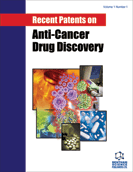
Abstract
The use of anticancer agents forms an important part for treatment of cancer of various types. Complexes with cis-platinum compounds have been used for the prevention and treatment of cancers. Quite a number of these metalcontaining complexes have been isolated, chemically prepared and characterized for the treatment of cancer. Many of these compounds display potent cytotoxic effects, although there is a considerable progress made in the design of novel anticancer agents. Some of these compounds showed strong inhibitory effects on cancer growth with a potential to become anti-cancer drugs. However, the unwanted deleterious effects hamper the common use of these agents as anticancer drugs. Nevertheless, the use of protective agents during, before or after treatment with anti-cancer agents in combination therapy has proven effective in the treatment. The results prompt the study of the biologic activities and the design of better modality for treatment and prevention of cancer. Here, we review the potential and reduction of cytotoxic properties of the prominent member of this class of metal compounds for the treatment of cancer.
Keywords: Cis-platinum, metal, 5-fluorouracil, granisetron, dexamethasone, anti-tumor, anti-cancer, combination therapy, ligands, cytotoxicity
Recent Patents on Anti-Cancer Drug Discovery
Title: Potential and Cytotoxicity of cis-Platinum Complex with Anti-tumor Activity in Combination Therapy
Volume: 1 Issue: 1
Author(s): John W. Ho
Affiliation:
Keywords: Cis-platinum, metal, 5-fluorouracil, granisetron, dexamethasone, anti-tumor, anti-cancer, combination therapy, ligands, cytotoxicity
Abstract: The use of anticancer agents forms an important part for treatment of cancer of various types. Complexes with cis-platinum compounds have been used for the prevention and treatment of cancers. Quite a number of these metalcontaining complexes have been isolated, chemically prepared and characterized for the treatment of cancer. Many of these compounds display potent cytotoxic effects, although there is a considerable progress made in the design of novel anticancer agents. Some of these compounds showed strong inhibitory effects on cancer growth with a potential to become anti-cancer drugs. However, the unwanted deleterious effects hamper the common use of these agents as anticancer drugs. Nevertheless, the use of protective agents during, before or after treatment with anti-cancer agents in combination therapy has proven effective in the treatment. The results prompt the study of the biologic activities and the design of better modality for treatment and prevention of cancer. Here, we review the potential and reduction of cytotoxic properties of the prominent member of this class of metal compounds for the treatment of cancer.
Export Options
About this article
Cite this article as:
Ho W. John, Potential and Cytotoxicity of cis-Platinum Complex with Anti-tumor Activity in Combination Therapy, Recent Patents on Anti-Cancer Drug Discovery 2006; 1 (1) . https://dx.doi.org/10.2174/157489206775246485
| DOI https://dx.doi.org/10.2174/157489206775246485 |
Print ISSN 1574-8928 |
| Publisher Name Bentham Science Publisher |
Online ISSN 2212-3970 |
 14
14
- Author Guidelines
- Graphical Abstracts
- Fabricating and Stating False Information
- Research Misconduct
- Post Publication Discussions and Corrections
- Publishing Ethics and Rectitude
- Increase Visibility of Your Article
- Archiving Policies
- Peer Review Workflow
- Order Your Article Before Print
- Promote Your Article
- Manuscript Transfer Facility
- Editorial Policies
- Allegations from Whistleblowers
Related Articles
-
Inhibiting Breast Cancer Progression by Exploiting TGFβ Signaling
Current Drug Targets Cellular and Molecular Networks in Chronic Myeloid Leukemia: The Leukemic Stem, Progenitor and Stromal Cell Interplay
Current Drug Targets E2F1-Mediated Apoptosis as a Target of Cancer Therapy
Current Molecular Pharmacology HIV Shedding in Cervico-Vaginal Secretions in Pregnant Women
Current HIV Research Small Molecules in Cancer Therapy: Cytotoxics and Molecularly Targeted Agents
Current Signal Transduction Therapy Do Not Say Ever Never More: The Ins and Outs of Antiangiogenic Therapies
Current Pharmaceutical Design Targeting the Ubiquitin Proteasome System: Beyond Proteasome Inhibition
Current Pharmaceutical Design Current Treatment Concepts of CML
Current Cancer Drug Targets Chemomodulating Effects of Flavonoids in Human Leukemia Cells
Anti-Cancer Agents in Medicinal Chemistry Microarrays and Colon Cancer in the Road for Translational Medicine
Current Bioinformatics Signal Transduction Therapy for Cancer - Whither Now?
Current Signal Transduction Therapy Effective Downregulation of BCR-ABL Tumorigenicity by RNA Targeted CRISPR-<i>Cas13a</i>
Current Gene Therapy Novel Inhibitors of Inosine Monophosphate Dehydrogenase in Patent Literature of the Last Decade
Recent Patents on Anti-Cancer Drug Discovery Targeting Strategies in Therapeutic Applications of Toxoplasmosis: Recent Advances in Liposomal Vaccine Delivery Systems
Current Drug Targets Survivin: Role in Normal Cells and in Pathological Conditions
Current Cancer Drug Targets FLT3 Inhibitors in the Management of Acute Myeloid Leukemia
Anti-Cancer Agents in Medicinal Chemistry A Brief Review of the Essential Role of Nanovehicles for Improving the Therapeutic Efficacy of Pharmacological Agents Against Tumours
Current Drug Delivery A Patent Review on the Use of L-Asparaginase in the Treatment of Acute Lymphocytic Leukemia
Recent Advances in Drug Delivery and Formulation Cancer Stem Cells in Pediatric Brain Tumors
Current Stem Cell Research & Therapy The Origin of Lentivirus Research: Maedi-Visna Virus
Current HIV Research


























